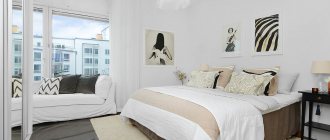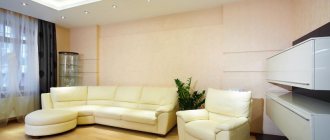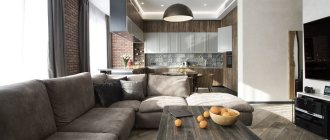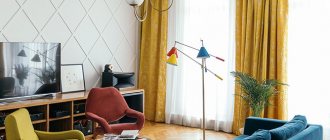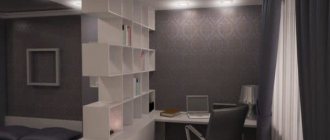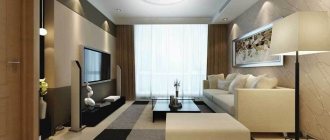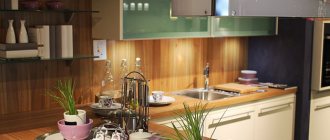The passage room in Khrushchev has always been a headache for homeowners. Soviet architects tried to delimit the already small area of apartments, often to the detriment of functionality and ergonomics. They tried to isolate the room by all available means: cabinets, partitions, screens and curtains. But is the walk-through room as bad as it seems at first glance? Modern room design techniques can turn the disadvantages of such rooms into advantages. We tried to collect photos of the design of walk-through rooms to show how a seemingly unsuccessful layout became the main highlight of the interior.
Design Features
Passage rooms have a number of positive and negative features that affect their design. This is the key room in the apartment, which imposes a number of restrictions on its design. The first of them is through traffic lines connecting the entrances to other rooms. These conditional corridors must be free so as not to interfere with movement. It will not be possible to use their area when arranging furniture. Next come the doorways. They “cut” the horizontal line of the walls, which also reduces the usable space. Thus, the useful area of the passage room is significantly reduced. In spacious rooms, the loss of space for passages is insignificant compared to the total, but in small rooms you can lose almost half of the free space.
The walk-through room is often used as a living room, which is logical, since it is common and requires insulation less than other rooms. Modern trends in interior design gravitate towards bright open spaces and the removal of all possible partitions, and walk-through rooms are already ready for such modifications.
Features of the layout and design of the living room
Layout of the living room and its further design is not an easy task. This is because this is not just a room, but a place for comfort, built primarily for the guest. I would like to make it such that guests gasp when entering it, and when leaving they remember it and tell their friends.
It is important to choose exactly the type of layout that will provide sufficient space and also allow you to implement the best design solutions.
When thinking about the ideal living room, you need to put yourself in the shoes of a guest and think about whether he would feel comfortable staying here - especially if you have to receive them often.
In any case, a good living room layout is primarily about comfort for the guest, not for the owner. In general, the following factors need to be taken into account.
- increased comfort;
- availability;
- environmentally friendly finishing;
- selection of design styles.
“Comfort zone” - you can often hear this expression addressed to the living room. This is true; in modern premises, the guest room is decorated and planned in such a way that guests really don’t want to leave. Moreover, it is pleasant for the owner to relax here when there are no guests in the house yet.
Although the living room is just a regular room for guests, it should not be located at the very end of the apartment or house. In general, there is no way to create another room in the apartment with your own hands, so one of the best ones is equipped specifically for these purposes.
Read here! Living room renovation - choosing a modern interior design and the best ideas for an updated style (85 photos)
In this case, you need to choose exactly the room that is located not far from the entrance of the apartment, but also not far from the kitchen - food must be served hot!
The decoration of the walls in the room should not only be beautiful, but also natural, environmentally friendly and safe for health. It is much more convenient for guests to be in the clean air; for this it is not at all necessary to keep the balcony open.
Even with the windows wide open, the air can be musty and, most importantly, harmful, which is unacceptable. Moreover, you need to receive guests in this room. At a minimum, for places where people gather, you need to select finishing materials that are safe for health.
And finally, you need to choose the design that the guest will like first. These should be calm, frequent tones, but not very calm.
The guest should not fall asleep at the table, but should not feel uncomfortable when surrounded by aggressive colors. It is enough to choose a color scheme that includes several, but pleasant colors, and then the guests will not want to leave.
Redevelopment
Redevelopment in an apartment with a walk-through room is the most radical way to improve the space of a room. In Soviet times, they tried to isolate the living room by creating long, dark corridors in apartments. Modern interior design, on the contrary, suggests combining rooms, abandoning halls, delimiting the space into conditional functional zones. By getting rid of unnecessary walls, you can increase the usable area of the room.
A walk-through living room in a Khrushchev-era building is a small, narrow and dark room, so combining it with another room will make it lighter and more spacious, allowing you to organize the space more usefully. The kitchen-living room is a familiar, much-loved technique for expanding rooms. You can also increase the space by adding a loggia. In this case, you will get more options for arranging furniture, without looking at the availability of access to the balcony. Combining the kitchen and bedroom is a rare technique; they usually try to isolate this area, but light translucent partitions made of plexiglass or airy textiles are preferable for a balanced composition than blank walls. From an apartment with a walk-through room you can turn it into a spacious studio, where only the bathroom remains isolated.
Before developing a design project, you should familiarize yourself with photos of walk-through rooms to make the room comfortable and functional. Any redevelopment requires approval from the relevant authorities, and if the “extra” walls turn out to be load-bearing, then such improvements will have to be abandoned. However, you can achieve a harmonious space without demolishing walls.
Doors for the passage room
Doors play an important role in the design of a walk-through room. We should not forget that they take up a lot of space in the open position, and with frequent movement, the owners rarely close them.
Therefore, doors are not at all necessary for living rooms, especially for small rooms where doors take up most of the free space.
Doors will be the best option for the design of walk-through rooms, which often serve as a bedroom.
The following door layouts are common today:
Adjacent doors (the doors will occupy only one corner, without taking up the free space of the room; often doors that are located close to each other are fenced off with curtains for greater aesthetics);
Diagonal doors (the use of diagonal doors with beveled glass will visually increase the volume of the living room; the space that separates the doors can be occupied by a sofa or TV);
Doors on one wall (this layout will allow you to arrange the room not only conveniently, but also effectively: the walls between the doors are often decorated with paintings, collages from photographs or shelves with books).
If there is no need to provide a walk-through living room with doors, designers advise using various types of curtains or curtains. Before executing the design, it is better to familiarize yourself with the photos of walk-through living rooms, which will create the necessary idea of the location of the doors.
Doors
When renovating walk-through rooms, owners and designers are faced with a large number of doorways located relative to each other in a wide variety of ways. Parallel through doors are one of the most successful locations. The passage line crosses the room, conditionally dividing it into two zones. A storage system behind sliding doors will fit well into a shallow “pocket”. And if you make the cabinet doors mirrored, the large piece of furniture will “dissolve” in space, visually increasing the area of the room. A similar technique can be used for diagonal openings. In this embodiment, the room is divided into a living room area and, for example, a dining room or office.
The adjacent arrangement of doors takes up only one corner of the room, and the rest of the space remains free, so problems with the arrangement of furniture usually do not arise. If there are two doors on one wall and a sufficient distance between them, it would be appropriate to arrange furniture and accessories symmetrically to the axis conventionally drawn between the openings. If the doors are too close, you can mask the distance between them with a mirror, the height of which should be level with the door frame.
Doors in the interior of a passage room should be as inconspicuous as possible. The effect is achieved by monochromatic painting of walls, frames and doors. Canvases with glass or mirror inserts will lighten the space. In the design of a walk-through room, it is better to focus on sliding doors. They take up less space.
Create your own space
If, on the contrary, you do not need a passage space, there is also a solution. For example, in a standard Khrushchev house you can move the doorway and allocate part of the passage room for a small corridor. Such reconstruction will have to be coordinated, but this technique will help create an individual personal space.
Comment on FB Comment on VK
Also in this section
Michael and Helen Miroshkin, architects of the Geometrix Design studio, talk about the principles of geometry using the example of their completed projects.
There are many ways to save on renovations, not only of an apartment, but even of a house. Olga Dukven, head of the Domostroy design studio, tells in detail how to do this.
In this article, Pavel Gerasimov from the Geometrium workshop will consider the pros and cons of natural materials, their practicality and ability to fit into the interior.
We tell you what an interior designer needs to know about modern acoustic systems so as not to step on the throat of his own song and speak the same language with the installer.
Pavel Gerasimov from the Geometrium workshop talks about how to choose the style of an apartment for a young family, how to properly plan the budget for implementing the desired solutions and how to think through the layout.
Designer and co-director of the Geometrium workshop Pavel Gerasimov talks in detail about where saving is pointless and what is worth spending money on in the interior.
Designer Anna Valder talks about Scandinavian style, white winter, black nights and interiors of Northern Europe. And she is not only a theorist, but, above all, a practitioner with a large portfolio!
Have you long dreamed of a cozy and stylish living room? Are you getting ready for a renovation? Selecting upholstered furniture and decor? Especially for you, invaluable advice from a practicing designer “Shoppitaly” on arranging a living room.
Living room
- this is the calling card of your home, this is the place where, most often, you receive your guests, it is where the whole family gathers after a hard day for evening leisure.
Of course, it all depends on the size of your house or apartment, on your habits and family traditions, but probably for most homes the living room is the largest and most “open” space. It is not without reason that in some families (or in different eras) this room was called “salon”, “hall”, “room for receiving guests”. And what is important, this is exactly the part of the house where all family members spend time
.
How can we make sure that all family members feel cozy and comfortable in this space, so that everyone has their own place, and at the same time, so that it is spacious? How to create a stylish living room interior
, adapted to the needs of the family and for receiving guests and holding family celebrations?
So, if you're thinking about renovating your living room, or are planning to redecorate your living room from scratch, you'll want to know some pro tips
on what to pay attention to.
1. One of the characteristics of modern living room design is its multifunctionality.
Before thinking through the interior and arranging the furniture, clearly formulate
what functions the living room performs
in your home?
Living room-dining room, living room-office, living room-game room
, and maybe even
living room-bedroom
?
Photo: The large living room space is conveniently zoned and at the same time decorated in a single key.
Determine what your family will do in this room
: watch TV, relax and have conversations, receive guests while sitting on the sofa, play board games and cards with the children, work on the computer, listen to music, and so on.
Think about whether you will set holiday tables there or will your dining room perform this function? Making a list like this is extremely important. Therefore, do not be lazy, because in the future it will be much more difficult for you to add and redo something. So, tip No. 1:
Clearly define the functions of the living room in order to correctly zone the space, conveniently arrange furniture and organize living room lighting, thought out for each of the zones.
2. A beautifully designed entrance will provide half the success of the living room interior. Photo: Thanks to wide transparent entrance doors, the living room will seem more spacious and brighter.
Unfortunately, not all owners have this opportunity, and it is not structurally possible to do this in all houses.
But if there is such an opportunity, try to enlarge the doorway, install double-leaf swing doors with glass inserts. To emphasize the importance of the living room and visually raise the ceiling, use doors with a transom at the top, which can be either with glass inserts or made of the same material as the door itself. Such doors always look especially festive and elegant. So, tip number 2:
Consider a beautiful entrance to the living room, it will emphasize the importance of this room and create a favorable impression from the very beginning.
3. Having a perspective from the very entrance to the room will visually expand the space. Photo: Space flows easily and freely from one room to another through properly organized doorways. Notice where your gaze lands as soon as you enter the living room.
Try to make sure that the input is not “blind” , i.e.
so that your gaze does not rest on the wall or side of the cabinet
.
If the features of the room are such that it is impossible to position the entrance “with a perspective”, then opposite the entrance, hang or place on the floor a large mirror in a beautiful frame, hang a picture with beautiful lighting, place a large vase on the floor. In general, make sure that when entering your living room, something beautiful and interesting attracts the eye. So, tip #3:
Give the entrance a perspective or, if this is not possible, make it interesting through decoration.
4. Determine the main character in the interior of your home. Remember how you choose a holiday outfit for yourself - most often, first you find a dress, and then select shoes, a clutch, a cape, etc. to go with it. I advise you to approach the design of the living room, and the design of the apartment in general, in the same way. Decide right away which space in the apartment will “rule the show”
, and build on it when designing the rest of the house.
Photo: In this interior, the living room decisively sets the color scheme for the interior. If this, in your opinion, should be a living room, then determine
in what style you would like to make it.
Maybe you like a tranquil living room in a classic style
, or you want to experiment and create
an art deco style living room
?
a Provencal style or shabby chic living room
be ideal for your bright apartment ?
Or maybe you are a fan of minimalist living rooms
?
Whatever style you choose, remember that all other rooms in your home should “play in tune” with the main one. I strongly advise against setting off fireworks and rushing, for example, from a Mediterranean-style living room
to a
high-tech
.
Then you will realize that there is no harmony and unity in your home; it will look more like an exhibition stand of a furniture store than a cozy family nest. Photo: An excellent example of a harmonious and well-balanced interior. The simplest exercise to check this
is to imagine your apartment without doors.
If what you see through the doorway from one room does not disturb the harmony and irritate the eye, then everything is fine. But if the bright orange or purple color of the kitchen suddenly bursts into the living room in neutral pastel colors through the doorway, then you should think about it. And either introduce orange/purple accents into the living room, or “extinguish” the kitchen. So, tip No. 4:
Immediately decide on the style of the entire apartment and select a key room that will set the rhythm for the whole house.
This will enhance the feeling of harmony in the house, the unity of space, and will help create a stylish, tasteful interior. 5. The right color and wall decoration can create the mood of your living room on their own.
Once you have decided on the style, you can move on to the color scheme.
And here an important aspect is the presence of natural light in the room. If the living room windows face north
or northeast, there will be very little sun in it, so it is not advisable to paint the walls in white, pearl and bluish shades.
They will all look “dirty” and gray. It is better to give preference to saturated tones and pay attention to the light - cold lamp light will only worsen the situation. But in a room whose windows face south
, be prepared in advance for the fact that all the colors will look yellower than what you choose on the palette. Therefore, either deliberately choose a slightly cooler shade, or filter natural light using blackout curtains and shutters.
Now a very common technique
– highlighting one wall with a brighter or darker shade or even a different texture. Be careful with this - if there are obvious problems in the geometry of the room and it lacks beautiful symmetry, then it is better not to emphasize this. Highlight walls that are truly beautiful, enhance the effect and emphasize them with a special arrangement of furniture, and you will provide a highlight to your interior.
Photo: In this interior, the designer decided to enhance the effect of the katin by highlighting the wall in a contrasting tone.
So, tip number 5:
Choose the color of the living room walls very carefully.
If possible, never neglect a test paint job on the wall. 6. Living room furniture should be both spectacular and functional.
If you have decided on the functions (point 1) and style (point 4), then it will not be difficult for you to determine which furniture to choose for the living room.
However, make sure to give it the most effective and comfortable location possible. Pay attention to the design features of the room. If you have a living room with a bay window
or large windows, you can effectively place a dining table in this area.
If you're lucky enough to have a living room with a fireplace
, create a nice sitting area around it with upholstered furniture and a couple of comfortable armchairs, just don't hang the TV above the fireplace - it's better to use an adjacent wall for this.
Photo: Eclecticism allows you to combine pieces of furniture of completely different styles within the same living room. The result is a living room interior “with character”.
Gone are the days when in the living room along the largest wall there was
a massive wall
,
a sideboard with dishes
for special occasions and other
bulky cabinets and speakers
.
The modern trend
is visual lightness, so if possible, place
low furniture
- a long closed shelf no higher than the coffee table to hide all the equipment, disks and other things.
If you want even more lightness, let this shelf not stand on the floor, but be hung on the wall. In a small living room, do not deny yourself the pleasure of placing a large, for example, corner sofa
(within reason, of course).
Large, uniform furniture will make the living room more spacious than a large number of small items. And never forget about the practical aspect - it should be convenient to walk between pieces of furniture without bumping into the corner of the table or touching the legs of the chair. It’s better to give up unnecessary chests of drawers and stands. The less furniture you have in your living room, the greater the effect it will produce. Photo: The main character of the living room is a cozy, stylish sofa. So, tip number 6:
Consider, first of all, the practical aspect when choosing furniture for the living room. Fill the interior with functional items first, and then add decorative ones if there is room.
7. The decor provides the finishing touch to the interior, giving it individuality and creating a mood.
Decor does not always mean incomprehensible dust collectors placed on shelves.
In general, these dust collectors are not decor at all, but extra “garbage” in the interior. Unless, of course, this is your exclusive collection of hand-painted marble figurines of elephants or nesting dolls. Photo: The effectiveness of vases is achieved through a variety of shapes.
In general, the principle for choosing decor is this:
choose large decorative items
,
do not be afraid of repeating elements
- they will only enhance the effect.
Play not with colors, but with textures and shapes of decorative items
.
Particularly significant decorative items are shown in small spaces - they allow you to simultaneously avoid fragmenting the interior and connect two adjacent spaces. Please note that decorative items cope with some functions much better than more monumental solutions. For example, with the help of a beautiful designer screen
or
a large fluffy carpet,
you can zone the space (separate the dining area from the sofas), without cutting the living room into two parts and leaving the possibility of communication between them.
Photo: An unusual screen can become a feature of your living room. So, tip No. 7:
When choosing decor for your living room, give preference to beautiful and functional things, as well as those decorative items that characterize you.
Stay with
Modern designers often face the problem of walk-through rooms.
When building premises in Soviet times, the passage room was an integral part of the layout: it became popular due to space saving, which negatively affected the functionality and originality of the room.
Houses that have retained the old layout do not look very good and organic, but there are many creative solutions to this problem.
Zoning
The allocation of functional areas in the walk-through living room is tied primarily to the location of the doorways. Partitions are rarely used in such rooms, but if it is necessary to isolate a working or sleeping area for one of the family members, they will be appropriate. To prevent partitions from cluttering up an already small space, they should be as light as possible. Pass-through shelving to the ceiling will create a border without blocking natural light. A sliding screen made of frosted glass in Japanese or French style will hide the bedroom from prying eyes. The use of LEDs in the design will help create a natural lighting effect for the area left without a window.
Zoning with wall decoration, a low podium, and multi-level ceiling structures would be appropriate. Regarding the latter, it should be remembered that multi-level ceilings look good in spacious rooms; they are not suitable for small rooms.
How to properly arrange furniture in the living room?
Classic planning techniques always remain relevant. A symmetrical arrangement option involves placing sofas and armchairs at the edges of the center, which can be a table or fireplace. Another great way to arrange furniture wisely is the U-shape. For a large private house, arranging the furniture in the walk-through living room diagonally is suitable; the furniture will stand at an angle to the walls.
Living room zoning ideas
In a studio or large house, where the living room is combined with a dining room or kitchen, you have to visually divide the entire area into functional areas. The design of a living room with zoning is planned carefully, because the harmonious filling of the room must remain thoughtful. To do this, several techniques are used: finishing color or texture, furniture or partitions.
Zoning the living room with wallpaper
Decorating the wall with contrasting wallpaper inserts helps highlight the functional areas of the living room, divide it and thereby give it the correct shape.
- Wallpaper is used to highlight the walls behind the sofa to outline a circle for gatherings with guests.
- If the living room is complemented by a fireplace or a decorative portal, it can be decorated in light colors and play with contrast by covering the wall with dark wallpaper with a large pattern.
- Two different types of wallpaper will help to visually divide the living room into a relaxation area and bedrooms.
- In a living room with a kitchen, the technique of using photo wallpaper works great, when a large print pattern attracts attention and shifts the emphasis to the sofa.
- Zoning of a small living room combined with a bedroom is achieved through contrast. Against a light neutral background, wallpaper in a dark, rich color attracts attention and accentuates it in the area near the sofa.
Zoning the living room with a ceiling
Finishing, ceiling lights, different shades visually divide the area without compromising the free space.
- To create a stylish living room interior, they use zoning with stretched fabrics and plasterboard structures, integrating spotlights.
- Decorative beams will help highlight the dining room or kitchen area. Long lamps and an elegant chandelier on the ceiling will fence off the eating area.
- An interesting effect is achieved by the transition of finishing from the wall to the ceiling.
Zoning the living room with plasterboard
Drywall solves problems with dividing the functional parts of a room in several ways: it is used to build walls, decorative partitions or structures as an alternative to shelves.
- After combining the kitchen and living room, you can leave part of the wall and decorate it with plasterboard.
- A small partition-shelf is built from this material to separate the sleeping area.
- Zoning the living room in an apartment with a plasterboard structure for flowerpots looks interesting. She will fence off the office or bed.
- Drywall in combination with contrasting wallpaper or decorative trim will designate a recreation area and become an accent element of the decor.
Zoning the living room with a shelving unit
This design helps solve the question of how to arrange furniture in the living room, because it is able to redesign the entire space and divide it into sections of the correct shape. Shelves will replace a load-bearing wall if you place them in twos opposite each other, and in a large room the shelving will play the role of a wall where you can hang a TV and set up a relaxation area.
Color design
Walk-through rooms in Soviet-era apartments are not spacious or have an abundance of natural light, and a large number of doors makes the room even more cramped. These shortcomings can be smoothed out by using light shades in the design and simple techniques for visually expanding the space. The most successful combinations of white with pastel colors: pearl gray, pale pink, soft olive. A single color scheme for the walls and ceiling will blur the boundary between them and make the ceiling higher. Large patterns on walls and furniture should be avoided; they “eat up” space. It can be visually expanded with the help of reflective and glass surfaces, as well as mirrors. Framed photographs on the walls under glass, a glossy cabinet surface, and a well-placed mirror will add light and lightness to the room.
Lighting
The lack of natural light forces the use of a large number of different lamps. A chandelier is traditionally used for general lighting, but this is not always appropriate for walk-through spaces. A large structure under a low ceiling will make the ceiling even lower, and the room will seem smaller. For walk-through living rooms, the best solution is spot lighting around the perimeter or a central group. Local light in the form of wall sconces is actively used. For each allocated zone it is necessary to provide independent lighting.
Necessary furniture and equipment in the living room
Now that you know the main functional areas in the living room, let's look at the main pieces of furniture in the sitting area of the living room. So, first of all, we need: a sofa(s), armchairs if necessary, a coffee table, furniture for television equipment, shelves for books.
Standard living room furniture has the following dimensions:
- the sofa has a depth of 74(90) cm and a width of 200 cm.
- Chair depth 60(74) cm, length 60(74) cm;
- cabinet for books and dishes 30 cm deep, length 80 and 120 cm;
- coffee tables depth from 40 to 80 cm, length from 60 to 140 cm.
If standard furniture does not fit into the dimensions of your living room, then you have two ways to solve this problem. Custom-made furniture or room remodeling.
Flooring
The floor covering in the passage room should be resistant to wear. Linoleum, laminate, and ceramic tiles are suitable for these purposes. The laminate must be at least class 32, and for tiles it is advisable to install a heated floor. You will have to discard the carpet; it will not withstand intensive use. A small rug in the guest area will add coziness to the room, but it should not be on the lines of the aisles. Flooring is often used for zoning. It is quite possible to highlight the passage from the hall to the kitchen through the living room with ceramic tiles with end-to-end doors, and finish the rest of the room with matching laminate.
Features of the layout of the passage room
Depending on the number of rooms in the apartment, there are from two to four doors in the entrance hall: from the corridor, to the kitchen, bedroom, dressing room, children's room. Doorways should not be blocked - communication between rooms should be free. Clear zoning makes sense only in large spaces - for small spaces, an open plan is suitable, in which a third of the wall or the entire wall is removed, forming a bedroom-living room or kitchen-living room. It’s also possible to end up in a cramped apartment from the hall, and it’s quite easy to attach an insulated balcony or loggia to the hall. Individual space is fenced off in the common room with a closet, screen, shelving, amounting to only a few square meters. If there is a walk-through room, the issue of complete redevelopment into a studio apartment is often considered.
It is preferable to design all doorways in the passage room the same way - this way the interior will look seamless.
Furniture
Arranging furniture in a walk-through living room often causes difficulties. An island arrangement of interior items is only possible in a spacious room. In a small room, furniture is placed along the walls to free up passages. The central place in the guest area is traditionally occupied by a sofa, but the length of the walls “cut” by doorways does not always allow the use of such a bulky piece of furniture. It can be replaced with an elegant ottoman and a pair of light armchairs in another part of the room. The room will look spacious, and if guests arrive, the furniture can be easily moved. Tables and hanging shelves made of glass look airy and do not weigh down the space. If both doors are located on the same wall, furniture and accessories are placed symmetrically to the openings. This interior looks balanced and harmonious.
Options
- In this version, the doors are built parallel to one another. They can be mentally connected in a straight line by a corridor. This is a pass-through. This design is one of the easiest to design. Place the sofa against the wall. Opposite, place a cabinet with a TV. But place the TV not at the opposite wall, but as if near the line of a conventional corridor.
- With this option, the doors are located in one of the corners of the room. This option for arranging passages can often be seen in modern apartments and houses. It turns out that only one corner is inaccessible for arrangement (the door next to it). If the doors are not built end-to-end, but there is space between them, you can put a floor lamp, a functional bedside table or a beautiful floor vase there. A comfortable design can be achieved if the sofa is placed opposite one door and the TV is placed against the opposite wall. There will be free space at the door where nothing will interfere with the free passage.
- This is an option when the doors can be mentally connected by a diagonal. It’s quite inconvenient, but rooms with such a layout in high-rise buildings, and even more so in private houses, are quite rarely built. Do not place furniture along this diagonal of the aisle. It will prevent the free movement of family members and guests from room to room. The best solution is to buy a sofa that you place in the corner and place the TV opposite. It’s convenient to have a small table next to the sofa for morning newspapers, so you can comfortably drink a cup of coffee or tea while reading. Fill the rest of the room with furniture of your choice. With this layout, let the doors be hidden. They will not attract undue attention. If you have such a room layout, feel free to choose this door design option.
- The doors are located on one of the walls. This layout is popular among Americans. It rarely comes across in the design of our living rooms. The best way to use the space is this: place a TV in the space between two doors, and place the sofa opposite. But when watching movies or programs, etc., family members will periodically pass in front of the screen. Either come to terms with it, or fantasize and find another optimal option for arranging a sofa with a TV for watching.
Decor
An interior without decor and accessories looks faceless and unfinished. And although there should be a minimum of them in the walk-through living room, you should not completely abandon the decor. The main thing is not to place accessories along the aisles so as not to interfere with movement. The laconic silhouettes of Roman and roller blinds, fashionable this season, would be appropriate for window decoration. Light translucent curtains to match the ceiling and walls will look elegant and stylish. When decorating, you should avoid large patterns and give preference to small floral patterns or plain textiles.
The interior of the passage room should be laconic and stylish. Preference should be given to light colors, light translucent textiles and glass furniture to create a bright and harmonious space.
